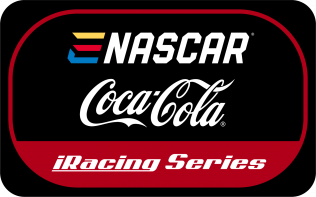eNASCAR Coca-Cola iRacing Series
| eNASCAR Coca-Cola iRacing Series | |

| |
| Inaugural season | 2010 |
|---|---|
| Current Champion | |
Founded in 2010, the eNASCAR Coca-Cola iRacing Series is the premiere NASCAR-sanctioned esports series featuring the top 40 qualifiers annually. Drivers qualify through the Road to Pro Ladder, beginning with the eNASCAR Qualifying iRacing Series followed by the eNASCAR Contender iRacing Series. The top 20 drivers at the end of each season are automatically qualified for the next season, while the bottom 20 drivers at the end of each season are relegated to the eNASCAR Contender iRacing Series where they are forced to requalify.
More than $1,000,000 (USD) in prize dollars have been distributed in series history.
Series History
In 2010, online racing competition commenced with the inaugural 18-race, 39-week 2010 NASCAR iRacing Drivers World Championship. The series featured the top 50 drivers from the NASCAR iRacing Pro Series and included then active NASCAR Cup Series driver Dale Earnhardt Jr. who won the first race at Daytona International Speedway on February 9, 2010. Drivers competed in the Generation 5 NASCAR Cup Series cars, nicknamed "The Car of Tomorrow." Selected races from the inaugural season were broadcast online on iRacing.com.
In 2013, the series transitioned to the new Generation 6 NASCAR Cup Series cars. Race broadcasts were now produced by PSRTV, and the entire season was streamed live on YouTube for the first time.
In 2014, iRacing and PEAK Antifreeze announced that PEAK would sponsor iRacing's top NASCAR-sanctioned online racing championship series. The eNASCAR PEAK Antifreeze Series powered by iRacing.com would see the world's top sim-racers compete for more than $20,000 in cash and prizes in precise digital models of Generation-6 stock cars over a 16-race schedule.
In 2016, RaceSpot TV took control of the broadcast rights to the series. Broadcasts remained on the iRacing YouTube channel.
In 2017, the series introduced the Playoff format where the top 8 drivers at the end of the Regular Season would advance to the Playoffs, with the top 4 drivers at the end of the 3-race Round of 8 would advancing to the winner-take-all championship race.
In 2018, the series qualification rules were changed and the field of drivers was reduced from 50 to 40 competitors.
In 2019, the series would celebrate its 10th anniversary season by appearing 3 times on live television. An exhibition race at Iowa Speedway took place on July 25, 2019 and became the first live television broadcast of a sim race in the United States. A second exhibition race at Rockingham Speedway would take place on August 29, 2019. The championship race at Homestead Miami Speedway on October 10, 2019 became the first points race to appear on television. This year also saw the team structure change significantly, with several NASCAR teams and esports organizations becoming the front-facing team affiliations for all drivers.
In 2020, soft drink manufacturer Coca-Cola was named the entitlement sponsor for the eNASCAR iRacing Series. The newly-renamed eNASCAR Coca-Cola iRacing Series began its 11th season on February 11, 2020. Alongside the newly announced sponsorship, the total prize package for the series increased to over $300,000 annually. Broadcast rights for the series were handed to iRacing who would produce the live broadcasts from their new in-house production studio.
In 2021, iRacing again changed the qualification requirements for the series. The revised eNASCAR Road to Pro ladder replaced the NASCAR iRacing Pro Series with the eNASCAR Qualifying iRacing Series and the eNASCAR Contender iRacing Series. The Playoff field was expanded from 8 to 10 drivers during the 2021 season.
In 2022, the series transitioned to the latest Generation 7 NASCAR Cup Series cars, nicknamed the "Next Gen."
In 2024, the series format was changed again with the addition of regular season segments, fixed setup races, sprint races, and heat races in points races. The prize package increased to a record $511,000 (USD) with a substantial increase in team incentive contributions.
Series Champions
Drivers Champions
All figures correct as of the 2024 eNASCAR Coca-Cola iRacing Series race at Homestead Miami Speedway on October 1, 2024.
R – First time participating in the eNASCAR Coca-Cola iRacing Series that season
Teams Champions
All figures correct as of the 2024 eNASCAR Coca-Cola iRacing Series race at Homestead Miami Speedway on October 1, 2024.
C – eNASCAR Coca-Cola iRacing Series Champion that season
R – First time participating in the eNASCAR Coca-Cola iRacing Series that season
See Also
List of eNASCAR Coca-Cola iRacing Series Drivers Champions
List of eNASCAR Coca-Cola iRacing Series Teams Champions
List of eNASCAR Coca-Cola iRacing Series Race Winners
List of eNASCAR Coca-Cola iRacing Series Championship 4 Appearances
List of eNASCAR Coca-Cola iRacing Series Playoff Appearances